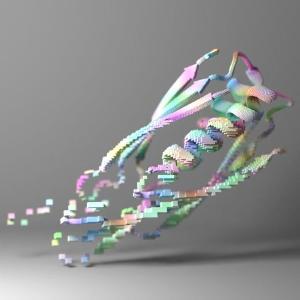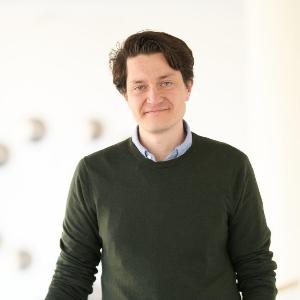Nanomachines made to measure: protein design with artificial intelligence
22 Aug 2025
Biophysicist Lukas Milles is a researcher at LMU’s Gene Center Munich. He investigates how to design completely new proteins with the help of deep learning.
22 Aug 2025
Biophysicist Lukas Milles is a researcher at LMU’s Gene Center Munich. He investigates how to design completely new proteins with the help of deep learning.
Proteins are the fundamental building blocks of life. They make up the structural components of our cells, they control our metabolism, they form part of our immune system – and also of the weapons with which pathogens attack us. It was long considered near impossible to design new proteins with targeted functions from scratch. But this is changing.
“Our research is de novo protein design,” explains Lukas Milles, professor and research group leader at LMU’s Gene Center Munich since 2024. “This means developing completely novel proteins that do not exist in nature.” The latest advances in the sphere of artificial intelligence have brought the goal of creating proteins with specially tailored properties within reach. The potential for applications is promising: For example, scientists can design drugs that specifically block harmful bacteria, or develop novel vaccines. An initial vaccine created by this process has been on the market since 2022.
Our research is de novo protein design. This means developing completely novel proteins that do not exist in nature.Lukas Milles

Deep learning can be used to design completely new proteins, which can then be tested for their function in the laboratory. | © Ian C. Haydon
“First, we consider precisely what the protein we want to create should look like – often with mere pencil and paper.” Next, the concepts are described mathematically and translated into three-dimensional protein structures via neural networks. “You can picture this like the process of generating an AI image: You describe the subject you want to see portrayed and the AI proposes various implementation options,” says Milles. Similarly, the biophysicist steers a deep learning model in the direction of desired protein designs.
Whereas with AI-generated texts and images, we generally try to avoid so-called hallucinations – say, the figures suddenly having three hands instead of two – Milles deliberately pushes for these outcomes: “We do not want our results to be slight variations of natural proteins, but brand-new solutions such as do not occur in nature.” After all, three hands could be rather useful depending on the application.
Milles’ team verifies in the laboratory whether the computed protein designs actually work. “Proteins are amino acid sequences. We get cells to manufacture these sequences, usually bacteria that have been modified such that they read synthetic genes that code for our proteins.” This produces a long amino acid strand, which twists itself into structures like a tangled telephone cord. Next, the scientists experimentally verify whether the molecular tangle really has the desired properties. “Controlling and predicting this three-dimensional configuration was extremely difficult until recently and could only be reliably addressed through deep-learning approaches,” says Milles.

Prof. Lukas Milles | © LMU / Jan Greune
Naturally enough, the AI does not just score direct hits. Depending on the complexity of the problem on which the researchers are working, it can happen that just one in a hundred designs prove worthy in the laboratory. “Biological systems are extremely complex. They don’t behave like a clockwork where you turn a little dial and know exactly what will happen.” Often there are no easy answers, says Milles. And although this is frustrating sometimes, it is also what makes his research field so compelling.
Milles was in the thick of things when the field took off. After completing his undergraduate studies and doctorate at LMU, where he worked on single-molecule biophysics from an early stage, he did research in Seattle under David Baker, one of the godfathers of protein design, who received the Nobel Prize in Chemistry in 2024 for his contributions to protein design. In 2024, Milles returned to the Max Planck Institute of Biochemistry and LMU through the German Research Foundation’s Emmy Noether Programme, this time with his own professorship.
Biological systems are extremely complex. They don’t behave like a clockwork where you turn a little dial and know exactly what will happen.Lukas Milles
What was a formative moment in his research career? “During my doctorate, I used a measuring system that allowed me to acoustically monitor what was happening in the experiment. As I was testing a new protein system, there was an unusually loud noise all of a sudden – I thought the instrument was broken. But it was actually a specific signal. And it was stronger than everything we had measured before.”
During his postdoc phase in the United States, there were other such Eureka moments. For example, Milles had to demonstrate a particular chemical bond which manifests itself by the investigated protein losing 17 daltons of mass. “I rummaged through the datasets until suddenly this 17 appeared in the results for the first time and I knew it had worked,” he recalls. “That was three-and-a-half years of work for this one number, which told me that an ammonium ion had split off from my protein.”
Bacteria have developed quite fascinating mechanisms. If we can better understand and reconstruct them, we might manage to flip them around to block bacterial invaders.Lukas Milles
Over the years, Milles had the opportunity on multiple occasions to leave fundamental research to move toward applied research in industry or to join start-ups. “I remained in basic research because it is so important and because it gives me a lot of freedom to try out new approaches.”
Protein design is an extremely interdisciplinary field at the interface of biology, physics, chemistry, and computer science. “LMU is excellently positioned and networked in these disciplines,” says Milles. He is a member of the BioSysteM Cluster of Excellence , in which researchers from LMU and TUM are collaborating with the goal of designing biological processes using engineering principles.
Milles and his team are currently working on gaining a better understanding of certain proteins by which pathogens attack human cells. “Bacteria have developed quite fascinating and sometimes counterintuitive mechanisms, which work extremely well,” he explains. “If we can better understand and reconstruct these mechanisms, we might manage to flip them around to block bacterial invaders.” After all, designing new proteins de novo can also teach us things about how natural proteins work.